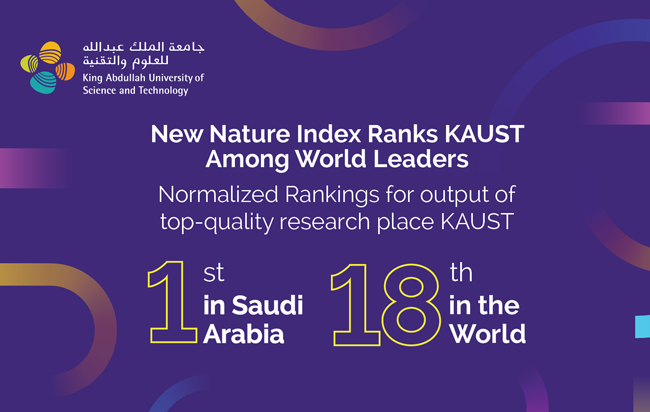New Nature Index Ranks KAUST Among World Leaders

The Nature Index Annual Tables showcase institutions with the highest outputs of top-quality research. For the first time, this includes a normalized ranking — placing King Abdullah University of Science and Technology (KAUST) as first in Saudi Arabia and in the global top twenty.
"It is fitting that as KAUST celebrates ten years of scientific discovery we are ranked by Nature to be amongst the top institutions in the world for the quality of our research. This is proof that with the right people, facilities, networks and opportunities even a young university can be considered world-class," says KAUST President, Dr. Tony Chan.
The new ranking considers the number of high-quality articles published as a proportion of an institute's overall output in the natural sciences, as opposed to a simple raw number of articles. This reveals a very different set of leaders among academic institutions.
"This achievement is a clear demonstration that KAUST punches well above its weight for a university of our size and age in terms of the proportion of our research output published in the world's top science journals," says Distinguished Professor Donal Bradley, Vice President for Research at KAUST.
"It is also a great recognition of the dedication of our researchers in pushing the boundaries of fundamental science while simultaneously addressing the pressing societal needs of today and tomorrow."
The top 100 Nature Index ranking draws on metrics known as the Article Count (AC) and Fractional Count (FC), which measure the number of articles and the contribution an institution makes to an article, respectively.
In contrast, the new normalized ranking is derived by considering the ratio of FC to the institution's total article output in natural sciences as tracked by the Dimensions database of Digital Science. The normalization calculation allows institutions of different size to be compared on the same basis.
"The inclusion this year of a normalized ranking draws to light some smaller institutes that are proportionally outstripping research powerhouses," says David Swinbanks, Founder of the Nature Index on announcement of the new rankings.
"The smallest institutions in the top ten have some common features: ambition, as disclosed by mission statements about striving to be the best in the world, interdisciplinarity, with the strong embrace of collaboration across fields, and in several cases, the backing of Nobel laureates."
For the full Nature Index Annual Tables, please click here.

